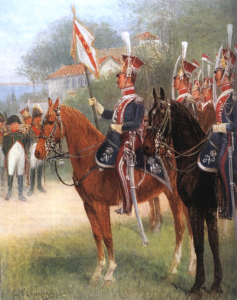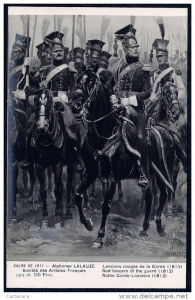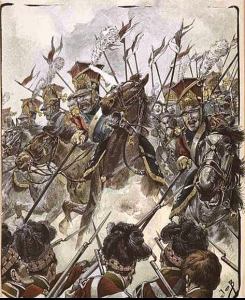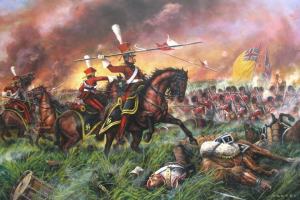The Elba Squadron during the 100 Days Campaign.
Following the Emperor’s abdication the new state offered Napoleon favourable terms under the Treaty of Fontainebleau on 11 April 1814.This document drawn up between Napoleon I and representatives from the Austrian Empire, Russia, and Prussia. The treaty was signed at Paris on 11 April 1814, by the plenipotentiaries of both sides, and ratified by Napoleon on 13 April With this treaty, the allies ended Napoleon’s rule as emperor of France and sent him into exile on Elba.
In effect it gave Napoleon a small army and retained a Polish Guard.
Article 17. — H.M. the Emperor may take with him and retain as his guard four hundred men, officers, non-commissioned officers, and privates.
Article 18. — All the Frenchmen who may follow H.M. the Emperor Napoleon and his family will be obliged to return to France within the term of three years if they do not wish to lose their destinction as Frenchmen, unless they are included in the employments that the French Government reserves itself the right to accord after the expiration of that term.
Article 19. — The Polish troops of all arms which are in the French service shall be at liberty to return to their homes, retaining their arms and baggage as evidence of their
honourable services ; officers, non-commissioned officers, and privates shall retain their decorations which have been accorded to them and the pensions attached to such decora-
tions.
The Treaty of Fontainebleau made Napoleon an independent Sovereign, or Prince. He called himself, with more right than humour, ” Napoleon, Emperor and King of the Island of Elba.” As an independent monarch he was, in theory, entitled to complete freedom of action. There was nothing in the treaty to prevent him from landing, when he chose, on the coast of Italy, or even of France, though no brother Sovereign was under any obligation to receive him as a visitor. Theoretically, and legally. Napoleon might go where he pleased, provided he obtained a passport or other permission to land on foreign soil. Practically, however, it was well understood that he was expected to remain quietly on his island, and that any attempt to leave it would be regarded as an assault upon the peace of Europe, and any monarch who received the perturbator would be considered a partner in the attack. What would be the situation if Europe declined, or neglected, to carry out her part of the
treaty, had not been considered
On the Island of Elba Major. Jerzmanowski took command of Porto Longone .He was put in charge of organizing the ships that would transport the loyal soldiers of the Emperor from the island. The Polish Elbe Squadron consisted of 125 men divided into a mounted company of 22 under Capitaine Jan Schultz (Szulc) a most imposing figure of a man 7 feet tall, former capitaine in the 7th Vistula Lancers and former POW of the English in Spain. a dismounted company of 96 men under the command of Capitaine Kajetan Baliński. The other officers in the squadron were 1st lieutenant Fiutowski and Koch, 2ndlieutenants, Tomasz Skowroński, Jozef Piotrowski and Baghoudoun Seraphin from the Mamelouks.
The NCO’s were Marechal des Logis Chef Raffaczynski, Marechals des Logis Jan Michniewicz Józef Poleski , Aleksander Piotrowski, Ludwik Trzebiatowski, Marcin Bielicki, Franciszek.Mierzejewski, Jan.Faszczewski, Stanisław Borowski, Józef Zaremba and Michał Szulc. Trumpeters were brigadier trompette Auguste.Ramones (Rammes) and trompette P.Duvelte, Prautt and Pawel Staszyński. Master Saddler was Józef Kiemacki.
During it’s time on Elba the squadron was divided for six months as Balinski with 55 men including 12 new recruits waited in Parma for Marie Louise. After returning in vain to Elba in October, Balinski took command of the squadron until Schultz commission was confirmed and officially took over the squadron.
 On the Island of Elba, the grenadiers and chasseurs were assigned to guard the Emperor. Lachoque writes, “Major Raoul, carrying a brace of loaded pistols and two Polish Guard Lancers escorted Napoleon every day.” There were horse races in which the Poles competed against the Elbans on their wild horses. For the opening of the carnival, Princess Pauline organized a costume ball at which Malet appeared as the Sultan and Captain Schultz of the Polish lancers as Don Quixote, to whom he bore a striking resemblance.
On the Island of Elba, the grenadiers and chasseurs were assigned to guard the Emperor. Lachoque writes, “Major Raoul, carrying a brace of loaded pistols and two Polish Guard Lancers escorted Napoleon every day.” There were horse races in which the Poles competed against the Elbans on their wild horses. For the opening of the carnival, Princess Pauline organized a costume ball at which Malet appeared as the Sultan and Captain Schultz of the Polish lancers as Don Quixote, to whom he bore a striking resemblance.
On the 26th of February 1815 it was reported that the horses of the Polish lancers were to be brought up from Pia Nosa immediately and that the saddlers are busily employed. That same night Napoleon sailed from Elba under the cover of darkness with 1,000 men and a treasury of 800.000 francs in gold to conquer France. The 100 Days had begun.
Napoleon leaves the Island of Elba.
The last week of March 1815 saw the Emperor back on the throne in Paris. Jerzmanowski’s poles were housed in their Parisian barracks. They were packed into 12 rooms devoid of beds or furniture and had to sleep on the floor. While the Poles were in Elba their homeland had been occupied by Russia and a new Polish/Tsarist army had been formed under Konstanty Pawtowicz. He sent orders to the Elba squadron to return to Poland under pain of the highest punishment. This order was ignored for the loyalty of Jerzmanowski and his Poles to the Emperor was beyond question.
On 21st of March the squadron was reviewed by the Emperor at the Tuilleries Palace in Paris and here the Emperor decreed the reconstitution of his Imperial Guard.
Under the 1st Restauration there was a single lancer regiment named as the Light Horse Lancer’s of the Imperial Guard formed from the Corps Royal des Chevau-Legers Lanciers de France. The 1st Polish Guard Lancer regiment could not be reformed, as what existed of it in 1814 had been disbanded and returned to Poland under it’s colonel Vincenty Krasinski. However, the Poles were able to form a squadron. Because of it’s strength the Polish Elba squadron was Incorporated into this regiment by Imperial decree of 22nd April 1815.
Article 1.
The light horse lancer’s of our Guard will be increased up to five squadrons organized to our decree of the 8th of this month.
Article 2
The first squadron will be formed entirely of Poles ,it will wear the uniform of the former Polish Lancer’s of the Guard and will be recruited from Poles who have taken service in France.
Article 3
The Polish Squadron will be commanded by Colonel Jerzmanowski, Major in the cavalry of Our Guard. The squadron will be under the orders of the Lieutenant-General, Colonel of the Light Horse Lancers of Our Guard; it will be treated and administered as for other squadrons by the Administrative Council of the regiment.
A few days later Napoleon revised the order and gave the poles the title of “The Polish Squadron”
 The combined regiment of Light Horse Lancers of the Guard was to have a strength of 826men and 869 horses and was to be commanded by General Colbert. By 10th of April the regiment had 53 officers and 621men and 538 horses. On June 1st this had been increased to 65 officers and 1,181men with 739 horses. By 10th of June and the commencement of the Belgian campaign 1,253 men and 955 horses made up the regiment. Shortages of horses meant that only 800 men could be effectively mounted.
The combined regiment of Light Horse Lancers of the Guard was to have a strength of 826men and 869 horses and was to be commanded by General Colbert. By 10th of April the regiment had 53 officers and 621men and 538 horses. On June 1st this had been increased to 65 officers and 1,181men with 739 horses. By 10th of June and the commencement of the Belgian campaign 1,253 men and 955 horses made up the regiment. Shortages of horses meant that only 800 men could be effectively mounted.
2nd Regiment of Guard Lancer’s – Alphonse Lalauze
On June 15, 1815, at around 2.30 am, Napoleon’s army crossed the Belgian border with the intention of attacking the English army commanded by the Duke of Wellington and the Prussian army under Field Marshal Blucher. In front of Napoleon’s army, cavalry reconnaissance units were moving, and among them, the Second Regiment of Lancers of the Guard as a part of the Cavalry Brigade of the Guard commanded by Charles Lefebvre-Desnoettes, part of the units of Marshal Michael Ney.
Moving towards Brussels, the 2nd Guard Lancers regiment approached the village of Frasnes. Fighting started late in the afternoon on 15 June, when the Lancer regiment tried to attack the allied force of Nassauers’ from the direction of Frasnes and parallel to the Charleroi Road. The defending forces consisted of the II/2nd Nassau regiment of 1,500 men and Bijlevelds horse artillery of 8 guns. The Dutch and Nassau commanders had taken precaution however, and as the red Lancers approached they were greeted by canister and volley fire, losing some men and horses before retiring to Frasnes. General Colbert led the Polish squadron around the village from the east, approaching Quatre Bras, without any resistance. When dusk broke, having received no support, it had to withdraw to Frasnes, clearing the enemy in front of it. The Dutch Nassau troops retreated up the Charleroi Road in good order to Bossu Wood pursued by the Red Lancer’s who skirted around Frasnes to the east before being checked again by brisk fire from the Nassauers’. Lefebvre-Desnoettes, reported that he had taken 15 prisoners and had suffered the loss or injury of 10 men.
Patrols were sent out by General Colbert and the positions were kept until the next morning.
On June 16, in line with Napoleon’s intention, the squadron, at the lead of the main forces moved against the Prussian army of Marshal Blucher. Marshal Ney was to fight against the English army, preventing it from coming to the Prussian’s aid.
At dawn, Ney’s units started preparations for the advance to Quatre Bras, however William the Duke of Orange, temporarily replacing Wellington, directed new units to this region with the task of delaying the French. At once, the alarm was sounded that the whole English army was moving with speed towards Quatre- Bras. The first forays happened at about 7.00 am when the Polish and Dutch lancers, taking some losses, attacked the Silesian Hussars when they were cut off from main forces of the Prussian army. The regiment then came under fire from Bijlevelds horse artillery battery. Charges against the battery, undertaken by the Dutch Lancers, failed under the cannon fire and Colbert with his regiment was withdrawn for the rest of the day and held in reserve. During the day the regiment did however cover the withdrawal of Gen. Kellermann’s Cuirassiers.
The Poles may not have been at Quatre-Bras despite what some historians have claimed. That can be confirmed by lack of any losses in the Polish squadron on that day
Throughout the afternoon of the 17th the French army followed the Anglo-Netherlands Army north. The Guard lancers in the advance- guard and under heavy rain clashed with the rear-guard of the British light-horse of General Vivian and Vandeleur near Thyle. The lancers were finally pushed back by the British 1st Life Guards.
On Sunday 18th of June the Lancers of the Guard under Colbert prepared for battle on the field of Waterloo, occupying the centre right of the battlefield behind Milhaud’s 1V heavy Cavalry Corps of Cuirassiers with the Guard Chasseurs a Cheval immediately on their left.
It was not until 4.00pm that Ney launched his first massed cavalry attack of 10 regiments and 34 squadrons, about 4,000 men of all ranks.
 All regiments advanced in echelon columns of squadrons. They advanced at the trot and more often at the walk over ground sodden by rain and through standing crops. They met the Anglo-Dutch army formed in squares with artillery strategically placed between the squares and cavalry in reserve.
All regiments advanced in echelon columns of squadrons. They advanced at the trot and more often at the walk over ground sodden by rain and through standing crops. They met the Anglo-Dutch army formed in squares with artillery strategically placed between the squares and cavalry in reserve.
The French cavalry were met by a solid wall of bayonet’s and steady well coordinated volley fire. The lancer’s did not break any squares but in their frustration De Brack says “Many of our troopers threw their weapons like spears into the front ranks of the enemy to try to open up the squares”
 Firing at point blank range casualties began to mount but this was made worse by artillery fire and the second ranks in the squares. Without support from artillery and infantry the cavalry were waisted in their futile attempt to break the Anglo-Dutch army. The Lancers were withdrawn and dismounted for three quarters of an hour and during this respite were able to view the grim and grizzly spectacle unfolding in front of them.
Firing at point blank range casualties began to mount but this was made worse by artillery fire and the second ranks in the squares. Without support from artillery and infantry the cavalry were waisted in their futile attempt to break the Anglo-Dutch army. The Lancers were withdrawn and dismounted for three quarters of an hour and during this respite were able to view the grim and grizzly spectacle unfolding in front of them.
During the afternoon the Guard lancers were engaged again against Allied light horse of the 1st Light Dragoons and the cavalry of the King’s German Legion, as well as artillery .Colonel Colbert rallied the lancers and led 2 squadrons of them forward driving back the Hanoverian cavalry. Fired on by artillery and with repeated intervention by the allied light horse the lancers were forced to fall back. Towards the end of the battle the Light cavalry of the Guard under Lefebvre-Desnoettes had been reduced to two and a half squadrons. It screened the French Army following the collapse of the Emperor’s Imperial Guard Infantry and formed up to support the retreat of the French army with what was left of the Old Guard with a strength of 100-150 officer’s and troopers from the lancers and Guard Chasseurs a Cheval.
On 23rd of June the squadrons of the Guard lancers mustered 30 officers and 507 lancers.
On June 21st Napoleon signed his abdication and soon after was exiled to Saint Helena.
Casualty figures for the Poles at Waterloo are confusing. Although the regiment of Guard lancers was heavily engaged at Waterloo, the losses of the Polish squadron have been recorded at 3% of the squadron, this being comparatively light The list includes five lancers Killed in action (Lukas Biernacki, Jan Nowak, Karol Pavlowski (Pawlowski) , Ignace Ruzyerko (Ruzyczko) and Sylwester Zeleski. Jan Malinowski, missing presumed killed) Marechal des Logis Michal Szulc taken prisoner,
Several were wounded and injured, among others, Colonel Jerzmanowski and Captain Baliński. Only a few lancers were lost during the retreat (probably due to the tiredness and exhaustion of their horses) when they were separated from the regiment and taken captive.
Another account gives the roll call near Leon on June 23rd as 2 officers,60 men and 60 horses present, with a further 10 men and 12 horses at the regimental depot. The squadron listed 8 men and 16 horses killed with 2 officers,29men and 19 horses as missing.
By mid August the Polish squadron left for Mirabeau for the commencement of their return to Poland. On the 29th of August its strength was 10 officers,179 troopers and 196horses.In Warsaw on the 1st of October 1815 the squadron was incorporated into the Russian-Polish Army of the Tsar.
 Within the grounds of the monument of the Fallen Eagle to commemorate the fallen of the French Army and the Guard there was erected in 1990 by the Polish Armed forces a fitting memorial to the officers, NCO’s and men of the Elba Squadron who fought and died at Waterloo (Mont-Saint-Jean) on the 18th of June 1815.
Within the grounds of the monument of the Fallen Eagle to commemorate the fallen of the French Army and the Guard there was erected in 1990 by the Polish Armed forces a fitting memorial to the officers, NCO’s and men of the Elba Squadron who fought and died at Waterloo (Mont-Saint-Jean) on the 18th of June 1815.
Bibliography.
Bielecki Robert: Szwoleżerowie gwardii, Warsaw, (1996)
Ryszard Morawski / Andrzej Nieuwazny – Gwardia: szwoleżerowie, tatarzy, eklererzy, grenadierzy (Karabela 2008)
Ronald Pawley – Napoleon’s Lancers of the Imperial Guard (Osprey 2007)
Ronald Pawley The Red Lancers: Anatomy of a Napoleonic Regiment (Crowood Press, 1998)
Wojciech Markert/ Dr. David Stefancic: The Polish squadron of the Imperial Guard at the battle at Waterloo (Military Office of Historical Studies)
Malarski Tomasz: Waterloo 1815, Warsaw, (1984)
Christopher Summerville : Who Was Who at Waterloo: A Biography of the Battle (2007)
Mark Adkin :The Waterloo Companion: The Complete Guide to History’s Most Famous Land Battle (2001)
Napoleon on Elba – Diary of an Eyewitness to Exile, by Sir Neil Campbell –(2004)
Archibald Neil Campbell Machlachlan :Napoleon at Fontainebleau and Elba; Being a Journal of Occurrences in 1814-1815, with Notes of Conve (2009)

